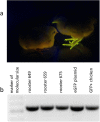Male fertility restored by transplanting primordial germ cells into testes: a new way towards efficient transgenesis in chicken
- PMID: 29079843
- PMCID: PMC5660165
- DOI: 10.1038/s41598-017-14475-w
Male fertility restored by transplanting primordial germ cells into testes: a new way towards efficient transgenesis in chicken
Abstract
The ongoing progress in primordial germ cell derivation and cultivation is opening new ways in reproductive biotechnology. This study tested whether functional sperm cells can be matured from genetically manipulated primordial germ cells after transplantation in adult testes and used to restore fertility. We show that spermatogenesis can be restored after mCherry-expressing or GFP-expressing primordial germ cells are transplantated into the testes of sterilized G0 roosters and that mCherry-positive or GFP-positive non-chimeric transgenic G1 offspring can be efficiently produced. Compared with the existing approaches to primordial germ cell replacement, this new technique eliminates the germ line chimerism of G0 roosters and is, therefore, faster, more efficient and requires fewer animals. Furthermore, this is the only animal model, where the fate of primordial germ cells in infertile recipients can be studied.
Conflict of interest statement
The authors declare that they have no competing interests.
Figures






Similar articles
-
Conservation of chicken male germline by orthotopic transplantation of primordial germ cells from genetically distant donors†.Biol Reprod. 2019 Jul 1;101(1):200-207. doi: 10.1093/biolre/ioz064. Biol Reprod. 2019. PMID: 30980659
-
Differentiation of donor primordial germ cells into functional gametes in the gonads of mixed-sex germline chimaeric chickens produced by transfer of primordial germ cells isolated from embryonic blood.J Reprod Fertil. 1999 Nov;117(2):291-8. doi: 10.1530/jrf.0.1170291. J Reprod Fertil. 1999. PMID: 10690196
-
Restoration of spermatogenesis after transplantation of c-Kit positive testicular cells in the fowl.Theriogenology. 2010 Dec;74(9):1670-6. doi: 10.1016/j.theriogenology.2010.07.002. Epub 2010 Sep 15. Theriogenology. 2010. PMID: 20833414
-
Germ cells and transgenesis in chickens.Comp Immunol Microbiol Infect Dis. 2009 Mar;32(2):61-80. doi: 10.1016/j.cimid.2007.11.010. Epub 2008 Feb 4. Comp Immunol Microbiol Infect Dis. 2009. PMID: 18249442 Review.
-
Male germ cell transplantation.Reprod Domest Anim. 2008 Jul;43 Suppl 2:288-94. doi: 10.1111/j.1439-0531.2008.01176.x. Reprod Domest Anim. 2008. PMID: 18638137 Review.
Cited by
-
An inducible germ cell ablation chicken model for high-grade germline chimeras.Development. 2023 Sep 15;150(18):dev202079. doi: 10.1242/dev.202079. Epub 2023 Sep 25. Development. 2023. PMID: 37665168 Free PMC article.
-
Generation of transgenic chickens by the non-viral, cell-based method: effectiveness of some elements of this strategy.J Appl Genet. 2018 Feb;59(1):81-89. doi: 10.1007/s13353-018-0429-6. Epub 2018 Jan 25. J Appl Genet. 2018. PMID: 29372515 Free PMC article. Review.
-
Functional Equivalence of Insulin and IGF-1 in the In Vitro Culture of Chicken Primordial Germ Cells.Genes (Basel). 2025 Apr 24;16(5):481. doi: 10.3390/genes16050481. Genes (Basel). 2025. PMID: 40428303 Free PMC article.
-
Reviving rare chicken breeds using genetically engineered sterility in surrogate host birds.Proc Natl Acad Sci U S A. 2019 Oct 15;116(42):20930-20937. doi: 10.1073/pnas.1906316116. Epub 2019 Oct 1. Proc Natl Acad Sci U S A. 2019. PMID: 31575742 Free PMC article.
-
Cas9-expressing chickens and pigs as resources for genome editing in livestock.Proc Natl Acad Sci U S A. 2021 Mar 9;118(10):e2022562118. doi: 10.1073/pnas.2022562118. Proc Natl Acad Sci U S A. 2021. PMID: 33658378 Free PMC article.
References
-
- Naito M, Harumi T, Kuwana T. Long term in vitro culture of chicken primordial germ cells isolated from embryonic blood and incorporation into germline of recipient embryo. J. Poultry Sci. 2010;47:57–64. doi: 10.2141/jpsa.009058. - DOI
Publication types
MeSH terms
LinkOut - more resources
Full Text Sources
Other Literature Sources

